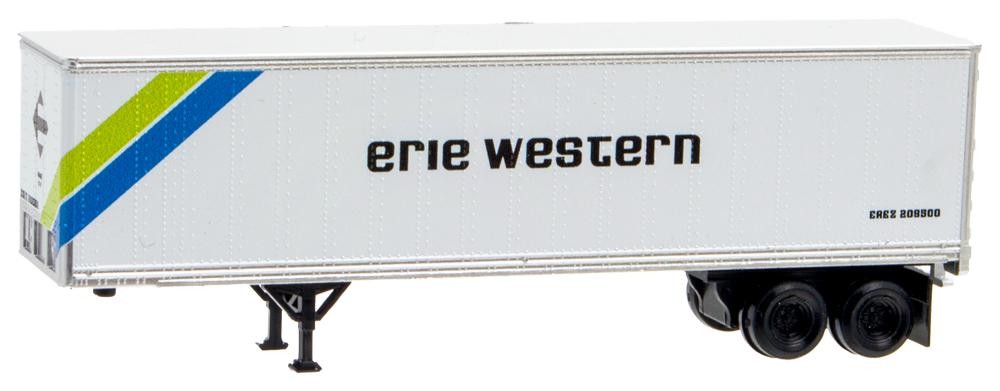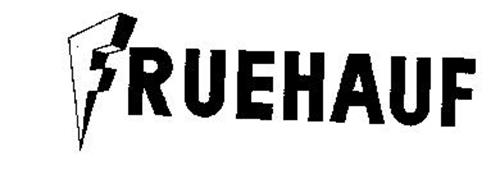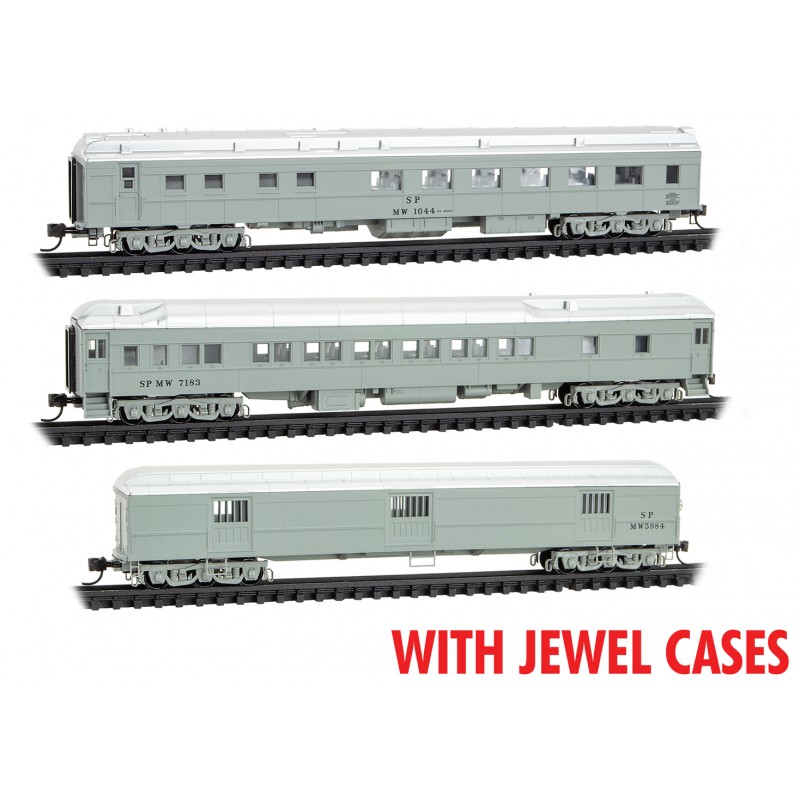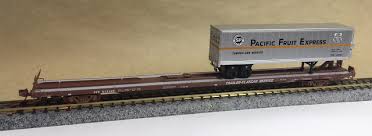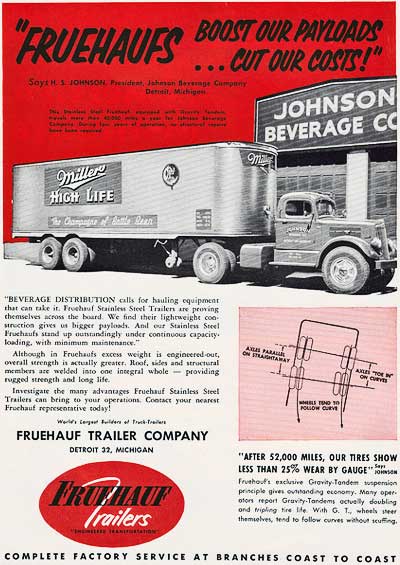Prototype History: Fruehauf Trailer produced a variety of different semi box trailers. During the 1960s the 40 and 45 foot dry models were quite popular and many are still in service today.
Road Name History: 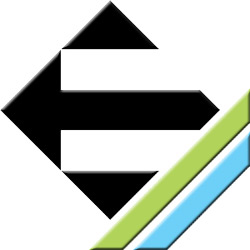 In the run up to the creation of Conrail in 1976, planners were free to leave duplicate routes out of the new system at which point local officials could make their own arrangements if they wished to preserve service. The Erie Lackawanna mainline west of Kenton, Ohio and running all the way to Chicago was left off the Conrail system. Conrail continued to run local service on the route with financial help from the state of Indiana until a local operator could be found.
In the run up to the creation of Conrail in 1976, planners were free to leave duplicate routes out of the new system at which point local officials could make their own arrangements if they wished to preserve service. The Erie Lackawanna mainline west of Kenton, Ohio and running all the way to Chicago was left off the Conrail system. Conrail continued to run local service on the route with financial help from the state of Indiana until a local operator could be found.
In 1977, the Erie Western launched operations from the Indiana-Ohio state line west to Hammond, Indiana not too far from Chicago. They also got a branch linking Decatur and Portland, Indiana. Trackage rights on the Chicago & Western Indiana got Erie Western trains from Hammond to Chicago. Total mileage was 185.
The Erie Western had enough traffic to keep 7 locomotives busy. That’s not a good sign since a healthy traffic level for a 185 mile line should require more than twice that many. Three former Long Island Rail Road hi hood C420’s (which never made it out of LIRR blue and yellow paint) were joined by four RS-3’s which were all painted in Erie Western white with blue and green stripes. All units were setup with the long hood as the front.
Erie Western also acquired a number of freight cars many of which were also white with blue and green stripes. These included 3-bay covered hoppers, 89’ flush deck flats for TOFC service and some 50’ boxcars.
Alas, the Conrail planners were right and the Erie Western ran out of money and shutdown in the summer of 1979. Another carrier, the Chicago & Indiana tried to run the line but shut down just 6 months later. Most of the route has been abandoned

In 1977, the Erie Western launched operations from the Indiana-Ohio state line west to Hammond, Indiana not too far from Chicago. They also got a branch linking Decatur and Portland, Indiana. Trackage rights on the Chicago & Western Indiana got Erie Western trains from Hammond to Chicago. Total mileage was 185.
The Erie Western had enough traffic to keep 7 locomotives busy. That’s not a good sign since a healthy traffic level for a 185 mile line should require more than twice that many. Three former Long Island Rail Road hi hood C420’s (which never made it out of LIRR blue and yellow paint) were joined by four RS-3’s which were all painted in Erie Western white with blue and green stripes. All units were setup with the long hood as the front.
Erie Western also acquired a number of freight cars many of which were also white with blue and green stripes. These included 3-bay covered hoppers, 89’ flush deck flats for TOFC service and some 50’ boxcars.
Alas, the Conrail planners were right and the Erie Western ran out of money and shutdown in the summer of 1979. Another carrier, the Chicago & Indiana tried to run the line but shut down just 6 months later. Most of the route has been abandoned
Brand/Importer Information: Micro-Trains is the brand name used by both Kadee Quality Products and Micro-Trains Line. For a history of the relationship between the brand and the two companies, please consult our Micro-Trains Collector's Guide.
Manufacturer Information:  Micro-Trains Line split off from Kadee Quality Products in 1990. Kadee Quality Products originally got involved in N-Scale by producing a scaled-down version of their successful HO Magne-Matic knuckle coupler system. This coupler was superior to the ubiquitous 'Rapido' style coupler due to two primary factors: superior realistic appearance and the ability to automatically uncouple when stopped over a magnet embedded in a section of track. The success of these couplers in N-Scale quickly translated to the production of trucks, wheels and in 1972 a release of ready-to-run box cars.
Micro-Trains Line split off from Kadee Quality Products in 1990. Kadee Quality Products originally got involved in N-Scale by producing a scaled-down version of their successful HO Magne-Matic knuckle coupler system. This coupler was superior to the ubiquitous 'Rapido' style coupler due to two primary factors: superior realistic appearance and the ability to automatically uncouple when stopped over a magnet embedded in a section of track. The success of these couplers in N-Scale quickly translated to the production of trucks, wheels and in 1972 a release of ready-to-run box cars.
Micro-Trains Line Co. split off from Kadee in 1990 to form a completely independent company. For this reason, products from this company can appear with labels from both enterprises. Due to the nature of production idiosyncrasies and various random factors, the rolling stock from Micro-Trains can have all sorts of interesting variations in both their packaging as well as the products themselves. When acquiring an MTL product it is very important to understand these important production variations that can greatly enhance (or decrease) the value of your purchase.
Please consult our Micro-Trains Collector's Guide

Micro-Trains Line Co. split off from Kadee in 1990 to form a completely independent company. For this reason, products from this company can appear with labels from both enterprises. Due to the nature of production idiosyncrasies and various random factors, the rolling stock from Micro-Trains can have all sorts of interesting variations in both their packaging as well as the products themselves. When acquiring an MTL product it is very important to understand these important production variations that can greatly enhance (or decrease) the value of your purchase.
Please consult our Micro-Trains Collector's Guide
Item created by: gdm on 2015-11-30 14:49:21. Last edited by gdm on 2019-02-04 08:01:41
If you see errors or missing data in this entry, please feel free to log in and edit it. Anyone with a Gmail account can log in instantly.
If you see errors or missing data in this entry, please feel free to log in and edit it. Anyone with a Gmail account can log in instantly.


